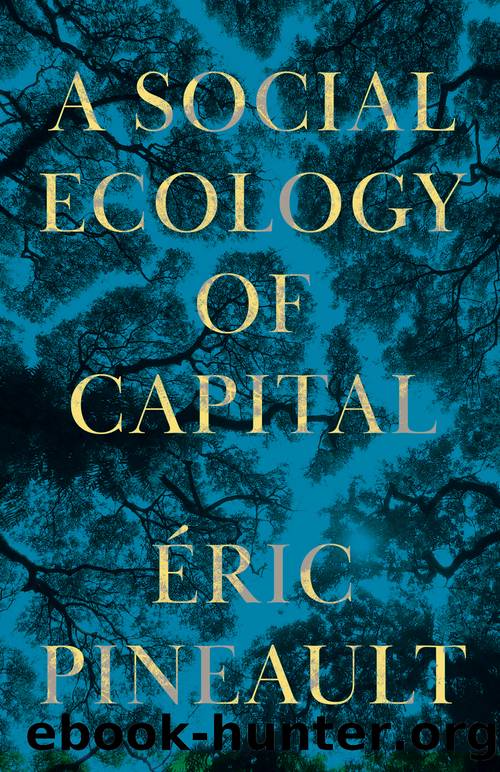A Social Ecology of Capital by Éric Pineault

Author:Éric Pineault
Language: eng
Format: epub
ISBN: 9780745343792
Publisher: Pluto Press
THE âPHYSIOCRATICâ STRUCTURE OF THE AGRARIAN METABOLIC REGIME
Figure 3.1 illustrates the constraints and structural relations of agrarian metabolism in a general and ahistorical manner.19 It is presented here as a conceptual tool with the purpose of highlighting through contrast the historical and ecological specificity of the fossil-based metabolic regime of capital, which will be presented further on. It is built as a two-sector model:20 on the one hand, a biophysical surplus production sector, around socially controlled NPP extracted from an agrarian metabolic cycle; and a biophysical surplus absorption sector consisting of non-agricultural social relations of extraction, production, consumption and dissipation.
On the left side of Figure 3.1, one finds the metabolic cycle of agrarian societies: an agricultural population of humans and animals has a defined quantity and quality of labor power that can be expended toward agricultural production and biomass extraction (from forests and bodies of water) through land use. Land use here refers to the colonization and creation of novel socialized ecosystems and their management to generate NPP with ânatureâs workâ existing as an autonomous ecological cycle. This results in a biomass-based social product that sustains both the agricultural and non-agricultural populations. The partition of the social product between these social groups depends on a diversity of social relations of distribution from reciprocity to tributary extraction to market exchange;21 it does not a priori imply exploitation, though often this has been the case. The analysis of each of these components of the metabolic cycle could be further refined, for example, the mode of existence of âlabor powerâ varies dramatically from one social form to another: between, for example, a free peasantry, bonded serfs, waged agricultural laborers and chattel slaves. A distinct characteristic of labor power in societies with an agrarian metabolism is the importance of animals which multiplied considerably the amount of work that can be mobilized as well as the power of each unit of labor mobilized by society.22 One estimate for Europe in 1750 calculates that the â38 million working animalsâ provided each European with double the work âthat could be exerted by his or her body alone.â23 Modes of tenure and ecological organization of land also vary, from common wastes and open fields to enclosed and improved pastures and crop fields to private plantations. Produced and extracted biomass also has variegated modes of existence as social wealth, sometimes presenting itself as an appropriable quantitative mass differentiated according to use and practice, sometimes presenting itself as non-appropriable because it is entirely caught up in reciprocal and care relations. Finally, the agricultural population itself is structured according to social relations of kinship, power and status. But the defining feature of the metabolic cycle is its dual mediation by labor and natureâs work in the form of socially oriented ecological productivity. Laboring bodies through their own metabolic activity are, with nature, the dynamic and active elements of this cycle.
On the right side of Figure 3.1, one finds a vertical structure that illustrates the relations of the non-agricultural population to this metabolic cycle, a dependence of this group on the extraction of surplus from this cycle.
Download
This site does not store any files on its server. We only index and link to content provided by other sites. Please contact the content providers to delete copyright contents if any and email us, we'll remove relevant links or contents immediately.
The Secret History by Donna Tartt(18843)
The Social Justice Warrior Handbook by Lisa De Pasquale(12141)
Thirteen Reasons Why by Jay Asher(8792)
This Is How You Lose Her by Junot Diaz(6791)
Weapons of Math Destruction by Cathy O'Neil(6142)
Zero to One by Peter Thiel(5685)
Beartown by Fredrik Backman(5594)
The Myth of the Strong Leader by Archie Brown(5424)
The Fire Next Time by James Baldwin(5248)
How Democracies Die by Steven Levitsky & Daniel Ziblatt(5127)
Promise Me, Dad by Joe Biden(5087)
Stone's Rules by Roger Stone(5026)
A Higher Loyalty: Truth, Lies, and Leadership by James Comey(4842)
100 Deadly Skills by Clint Emerson(4840)
Rise and Kill First by Ronen Bergman(4701)
Secrecy World by Jake Bernstein(4643)
The David Icke Guide to the Global Conspiracy (and how to end it) by David Icke(4624)
The Farm by Tom Rob Smith(4434)
The Doomsday Machine by Daniel Ellsberg(4415)
